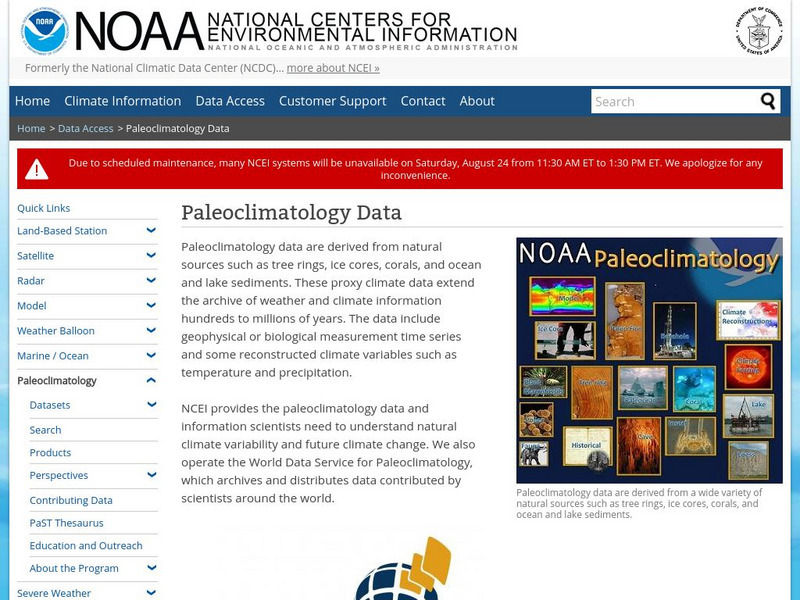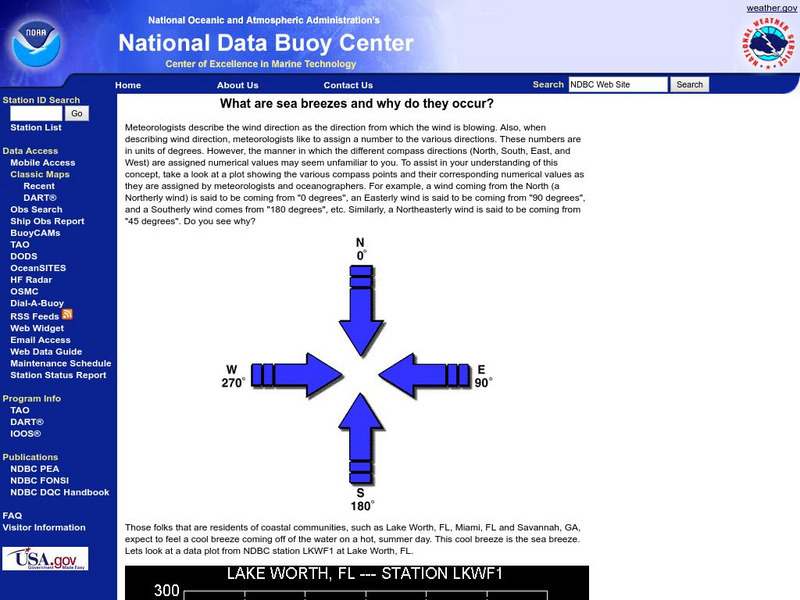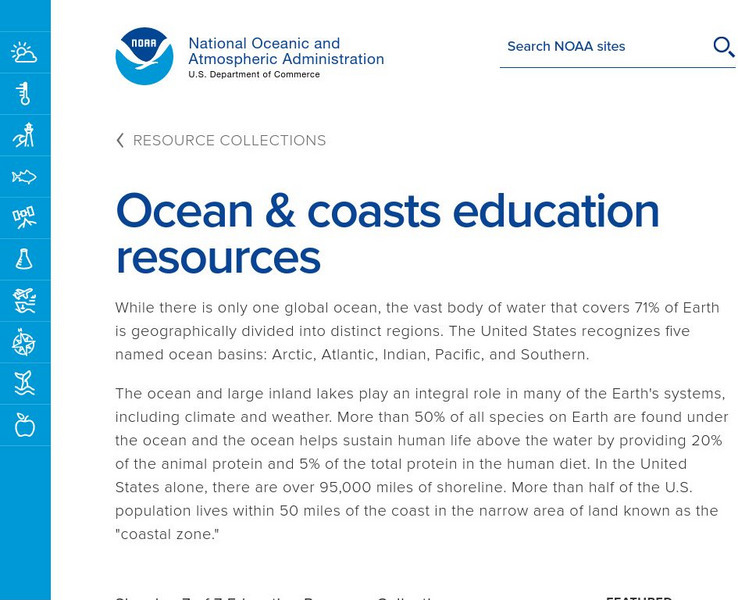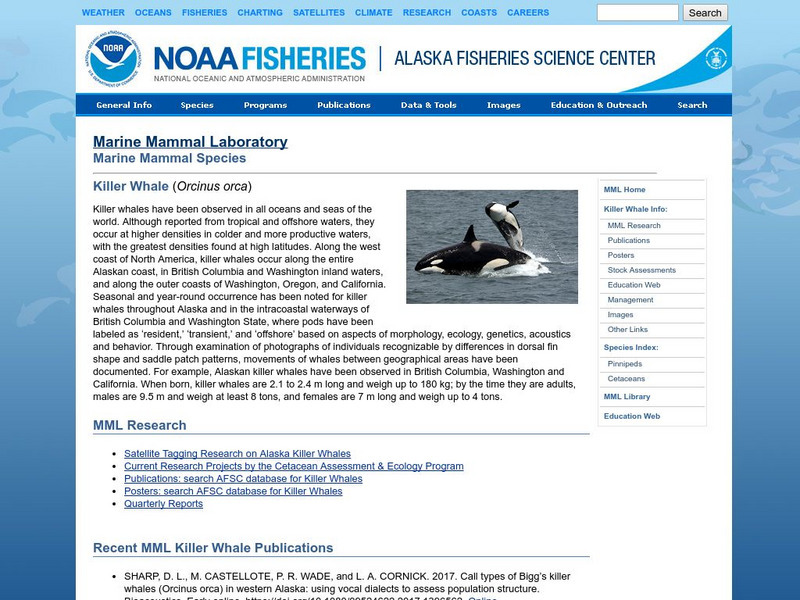NOAA
Noaa: Tornadoes
This online quiz will test your knowledge of tornado safety. Take it and see if you really are well prepared.
NOAA
Noaa: International Tsunami Information Center: Tsunami, the Great Waves
National Oceanic and Atmospheric Administration defines a tsunami and links to related pages about what causes tsunamis and how lives can be saved from their devastation.
NOAA
Noaa: Nssl: Doppler Radar
Discusses doppler and nexrad radar systems and how they work. Explains the doppler effect. Describes some of the accomplishments of doppler radar and the radar signatures used to identify specific storm features like tornadoes.
NOAA
Noaa: Paleoclimatology Program: Astronomical Theory of Climate Change
Use this site to learn how the Earth's not-so-circular orbit around the sun has affected our climate over thousands of years, and continues to affect our climate now.
NOAA
Noaa: Outflux: City Climate Comparisons
An interactive comparable climate data tool where the user chooses from a list of United States cities and several weather factors. The immediate result is a graph or graphs of historical US city data.
NOAA
Noaa: Build an Underwater Robot [Pdf]
Construct an underwater robot to explore below the surface. Change to the robot to make it work to meet your expectations.
NOAA
Noaa: Arctic Marine Animals
This slide show contains pictures of invertebrate arctic animals filmed during a 2005 expedition. Each photograph has a short description of the animal. There are ten animals displayed.
NOAA
Noaa: Ocean Explorer: Rms Titanic Expedition 2004
Dr. Robert Ballard returns to the Titanic after his famous discovery in the 1980s. Dr. Ballard and scientists from NOAA spent eleven days conducting scientific analyses of its deterioration. Three lesson plans are available that focus on...
NOAA
Noaa: Deep Sea Biologist
This resource provides information about the career of deep sea biologist.
NOAA
Noaa: Storm Prediction Center
Get real time data on storms across the nation that have occurred over the past 24 hours. The data includes storm locations, severity and brief damage reports.
NOAA
Noaa: National Data Buoy: What Are Sea Breezes?
National Data Buoy gives a good explanation of what sea breezes are and why they occur. Charts and illustrations are used on this page.
NOAA
Noaa: Marine Turtles
The NOAA Fisheries gives a brief overview of the conservation efforts, threat, and the status of the seven marine turtle species. Be sure to click on the individual species to get more information.
NOAA
Noaa: Freshwater
This site is designed to assist the educator in teaching concepts and processes related to freshwater environments and to increase stewardship of these important resources. There are links to resources regarding the Great Lakes...
NOAA
Noaa: Gulf Oil Spill Educational Resources
NOAA provides educational resources regarding the Gulf of Mexico oil spill such as imagery, animations, videos, lessons, activities, real world data, trajectory maps, and background information. Lessons such as Cleaning Oiled Feathers...
NOAA
Noaa: Ocean and Coasts
This website highlights the oceans of the world. Even though June is World Ocean Month, learning about oceans never ends! There are links here to many resources and lesson plans regarding the Arctic, Atlantic, Indian, Pacific, and...
NOAA
Noaa: National Hurricane Center: Hurricane Ivan Prelim Report [Pdf]
While this can be technical, if you want to know about this powerful hurricane, look here. This report is from Sept. 1998. Requires Adobe Reader. [PDF]
NOAA
Noaa: Ocean Explorer: Off Base Acidity of Oceans
A student inquiry into properties of the ocean's carbonate buffer system, and how changes in atmospheric carbon dioxide levels may affect ocean pH and biological organisms that depend on calcification.
NOAA
Noaa: Fisheries: Coral Reefs and the Endangered Species Act [Pdf]
Explore a comprehensive petition regarding the legal preservation of coral reefs and learn how the U.S. Endangered Species Act works to protect the reefs. PDF (requires Adobe Reader).
NOAA
Noaa: Ocean Explorer: The Methane Circus
In this activity students will understand the events occuring during the Cambrian explosion. They will also begin to explain how methane hydrates contribute to global warming. Finally, they will discuss links between methane hydrates...
NOAA
Noaa: National Weather Service: Hail
"Imagine a baseball dropped from an airplane flying at 30,000 feet; imagine that baseball reaching speeds of 120 MPH as it falls to the ground; and imagine you're under it!" How does hail form? How big can it get? Read more here about...
NOAA
Noaa: Restoration of Coral Ecosystems
The Coral Reef Restoration Center provides reasons why coral reefs are being destroyed, current or recent restoration activities, and future restoration efforts.
NOAA
Noaa: National Severe Storms Laboratory: Tornadoes
Find out how tornadoes occur, how they are predicted, the smallest size, the largest size, and how they are detected.
NOAA
Noaa: Environmental Technology Lab: Infrasonics Program
This resource focuses on research of infrasonic sounds found in the environment. It discusses such infrasonic sources as volcanoes, avalanches, severe thunderstorms, and earthquakes.
NOAA
Noaa: Killer Whale
This site has a nicely detailed presentation of the Killer Whale. There are a couple of nice images included in the description.






![Noaa: Build an Underwater Robot [Pdf] Activity Noaa: Build an Underwater Robot [Pdf] Activity](http://content.lessonplanet.com/resources/thumbnails/457131/large/bwluav9tywdpy2symdi0mdkwoc0xnjcwndu4lxfrcwq4cc5qcgc.jpg?1725776715)








